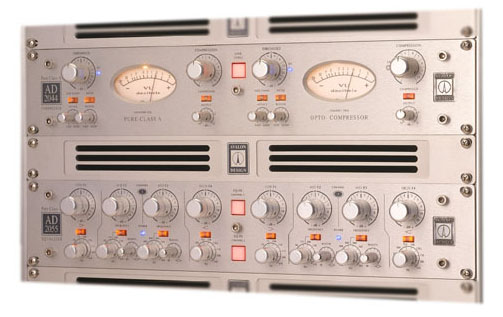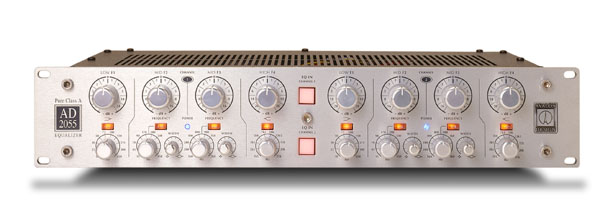|
AVALON
DESIGN
AD2044
& AD2055

K.K. Proffitt
examines two processors from Avalon Design
and
finds some able mixing and mastering tools for the studio.
| By
KK Proffitt for Audio Media Magazine- All Rights Reserved 6/10/01
|
Avalon Design’s AD2044 Opto- Compressor and AD2055
Class A Equalizer deliver sonic excellence in a sleek, stainless steel
package. Both continue the Avalon tradition of balanced, high voltage,
100% discrete, pure Class A signal amplifiers. External 150W torroidal
power supplies ensure clean power with minimal environmental hum in
the studio. Both units feature pin-2-hot balanced XLRs, with a maximum
input level of +30 dB. Maximum output level for both is + 32 dB balanced
600 ohms, DC coupled and high-current discrete Class A. High headroom
(+30 dB) with very low noise in these units provides signal integrity
with the emphasis on musical performance.
The AD2055 Class A Equalizer

The “passive-active filter design” of the AD2055 combines
flexibility and detail with ergonomic efficiency for fast-paced session
work. High and low frequency bands are passive, while the two mid bands
are active parametric. Both channels of the unit have the same functional
layout.
The passive low frequency band, LOW F1, has an amplitude ranging from
–32 dB to +32 dB at the low center point of the volume pot. It
has ten switched frequency positions: 18Hz, 25hz, 30Hz, 50Hz, 72Hz,
100Hz, 150Hz, 215Hz, 300Hz, and 450Hz. A switch between the volume pot
and frequency switch toggles between shelf or peak-dip curve.
The lower middle band, MID F2, is active with amplitude that varies
from –16dB to +16dB. It’s peak-dip curve features variable
Q with a width from 0.3 to 3.0. The frequency pot varies from 35 Hz
to 450 Hz. A x 10 switch above the frequency and Q pots boosts the frequency
range to 350 Hz for the lower value and 4.5kHz for the larger value.
The higher middle band, MID F3, is also active with a –16 dB to
+16 dB amplitude range and peak-dip curve with a Q whose width varies
from 0.3 to 3.0. It’s frequency range varies from 160Hz to 2kHz.
Setting the x 10 switch changes that to a low of 1.6kHz and a high of
20kHz.
Hi band F4, HIGH F4, is passive with a ten position frequency switch:
1.5kHz, 2.5kHz, 3.5kHz, 5kHz, 7.2kHz, 10kHz, 12.5kHz, 15kHz, 20kHz,
and 25kHz. Amplitude ranges from –26 dB to + 26 dB at the lower
center position of the volume pot. Like the low frequency band, there’s
a switch for shelf, or peak-dip curve.
The AD2055’s dual mono operation includes two large, red switches
on the center front of the unit. These two hard-wire relay bypass switches
for EQ in-out cause a slight thump below 125 Hz and should not be switched
during record.
We stacked the AD2055 on top of the AD2044 with a 1/2 inch of fire-resistant
foam board on the edges for spacing and ventilation. In the open air
of a room with 73-degree temperature, the heat sink on the AD2055 measured
135 degrees. The air just above the top unit was 112 degrees. If you’re
going to use these units in a rack together, they should have plenty
of ventilation.
The AD2044 Opto-Compressor

If I could only choose one word to describe the AD2044 Opto-Compressor
it would be smooth. It’s high-speed linear opto elements are computer
matched, providing a passive attenuator system with nearly transparent
gain reduction. Like the AD2055 equalizer, the AD2044 has high headroom
and low noise with high-voltage 100% discrete, pure Class A signal amplifiers.
The AD2044 features a wide bandwidth: -3dB, 1Hz to 450kHz. Traditional
LDR (light dependent resistor) compression combines with external control
loop and current monitored optical driver for smooth control and excellent
sonic character.
The two illuminated meters can be switched for gain reduction (0dB to
–20dB range) or output (professional moving coil, -20dB to +3dB
at VU=+4dB). To the left and above the meter is the variable Threshold
knob (-24dB to +20dB). The Compression knob resides to the right and
above the meter, with ratio-compression variable from 1:1 to 20:1. The
smaller Attack and Release pots reside to the left and below the meter.
Attack varies from 0.5mS to 150 mS; release varies from 80 mS to 5 seconds
for 12 dB release. Just above the attack and release pots are the side-chain
switch and the meter type toggle. Underneath the Compression knob is
the compressor bypass switch and the Output gain range pot.
On the back panel are XLR jacks for left and right input and output
as well as side-chain inputs for each channel.
You can run the AD2044 dual mono, or press the red Link switch in the
center of the front panel for stereo operation. In link mode, the left-side
attack, release and compression ratio govern the unit, while threshold
and output gain remain independent for both sides.
Listening
We checked the AD2044 and 2055 in several situations: vocals, drums,
and stringed instruments.
I had recorded a young cellist performing a complex solo piece. It included
bowed and plucked techniques with a “slapping” section in
the center of the piece, where giving the strings a light tap against
the fingerboard produced a flamenco effect. While I was, for the most
part, happy with the tonal balance and spatial characteristics of the
mix, I knew it could be better. With the AD2055, I brought out the “slaps”
so that they had a bit more point and also pulled in some lower mids
for more “woodiness” in the cello bowed tones. It was subtle,
but the cello had more visibility in the mix when I had finished.
I also used the AD2044 as well as the AD2055 on a young girl’s
vocals. I was able to bring her slightly variable performance under
control as well as give her a bit more “throat” while reducing
some of her rather shrill “belt voice”.
We also recorded a set of Arbiter flats, drums that consist only of
drum heads with shells, into Nuendo at 96kHz. My partner, Joel, declared
that “it’s impossible to get a really bad sound out of the
AD2044”. He varied attack and release for different samples.
After a final evaluation, we decided to buy both units. Low noise, sonic
musicality, and flexibility with attention to detail make the Avalon
AD2044 Opto-Compressor and the AD2055 Class A Equalizer must-have additions
for the professional mixing and mastering environment.
Back to Reviews Index & User List
| 
